[English] 日本語
 Yorodumi
Yorodumi- PDB-1hhk: THE ANTIGENIC IDENTITY OF PEPTIDE(SLASH)MHC COMPLEXES: A COMPARIS... -
+ Open data
Open data
- Basic information
Basic information
| Entry | Database: PDB / ID: 1hhk | ||||||
|---|---|---|---|---|---|---|---|
| Title | THE ANTIGENIC IDENTITY OF PEPTIDE(SLASH)MHC COMPLEXES: A COMPARISON OF THE CONFORMATION OF FIVE PEPTIDES PRESENTED BY HLA-A2 | ||||||
 Components Components |
| ||||||
 Keywords Keywords |  HISTOCOMPATIBILITY ANTIGEN HISTOCOMPATIBILITY ANTIGEN | ||||||
| Function / homology |  Function and homology information Function and homology informationsymbiont-mediated perturbation of host exit from mitosis / : / symbiont-mediated perturbation of host cell cycle G0/G1 transition checkpoint / symbiont-mediated perturbation of host cell cycle G1/S transition checkpoint / T cell mediated cytotoxicity directed against tumor cell target / antigen processing and presentation of endogenous peptide antigen via MHC class I via ER pathway, TAP-dependent / positive regulation of memory T cell activation / TAP complex binding / antigen processing and presentation of exogenous peptide antigen via MHC class I / Golgi medial cisterna ...symbiont-mediated perturbation of host exit from mitosis / : / symbiont-mediated perturbation of host cell cycle G0/G1 transition checkpoint / symbiont-mediated perturbation of host cell cycle G1/S transition checkpoint / T cell mediated cytotoxicity directed against tumor cell target / antigen processing and presentation of endogenous peptide antigen via MHC class I via ER pathway, TAP-dependent / positive regulation of memory T cell activation / TAP complex binding / antigen processing and presentation of exogenous peptide antigen via MHC class I / Golgi medial cisterna / positive regulation of CD8-positive, alpha-beta T cell activation / CD8-positive, alpha-beta T cell activation / positive regulation of CD8-positive, alpha-beta T cell proliferation / CD8 receptor binding / endoplasmic reticulum exit site /  beta-2-microglobulin binding / TAP binding / beta-2-microglobulin binding / TAP binding /  protection from natural killer cell mediated cytotoxicity / antigen processing and presentation of endogenous peptide antigen via MHC class I via ER pathway, TAP-independent / antigen processing and presentation of endogenous peptide antigen via MHC class Ib / regulation of mRNA stability / detection of bacterium / protection from natural killer cell mediated cytotoxicity / antigen processing and presentation of endogenous peptide antigen via MHC class I via ER pathway, TAP-independent / antigen processing and presentation of endogenous peptide antigen via MHC class Ib / regulation of mRNA stability / detection of bacterium /  T cell receptor binding / positive regulation of ferrous iron binding / positive regulation of transferrin receptor binding / early endosome lumen / positive regulation of receptor binding / Nef mediated downregulation of MHC class I complex cell surface expression / DAP12 interactions / negative regulation of receptor binding / lumenal side of endoplasmic reticulum membrane / Endosomal/Vacuolar pathway / Antigen Presentation: Folding, assembly and peptide loading of class I MHC / antigen processing and presentation of exogenous protein antigen via MHC class Ib, TAP-dependent / cellular response to iron(III) ion / negative regulation of forebrain neuron differentiation / ER to Golgi transport vesicle membrane / response to molecule of bacterial origin / T cell receptor binding / positive regulation of ferrous iron binding / positive regulation of transferrin receptor binding / early endosome lumen / positive regulation of receptor binding / Nef mediated downregulation of MHC class I complex cell surface expression / DAP12 interactions / negative regulation of receptor binding / lumenal side of endoplasmic reticulum membrane / Endosomal/Vacuolar pathway / Antigen Presentation: Folding, assembly and peptide loading of class I MHC / antigen processing and presentation of exogenous protein antigen via MHC class Ib, TAP-dependent / cellular response to iron(III) ion / negative regulation of forebrain neuron differentiation / ER to Golgi transport vesicle membrane / response to molecule of bacterial origin /  regulation of erythrocyte differentiation / regulation of iron ion transport / MHC class I peptide loading complex / HFE-transferrin receptor complex / T cell mediated cytotoxicity / cellular response to iron ion / antigen processing and presentation of endogenous peptide antigen via MHC class I / positive regulation of T cell cytokine production / MHC class I protein complex / regulation of erythrocyte differentiation / regulation of iron ion transport / MHC class I peptide loading complex / HFE-transferrin receptor complex / T cell mediated cytotoxicity / cellular response to iron ion / antigen processing and presentation of endogenous peptide antigen via MHC class I / positive regulation of T cell cytokine production / MHC class I protein complex /  SH3 domain binding / multicellular organismal-level iron ion homeostasis / positive regulation of T cell mediated cytotoxicity / peptide antigen assembly with MHC class II protein complex / negative regulation of neurogenesis / MHC class II protein complex / positive regulation of receptor-mediated endocytosis / cellular response to nicotine / recycling endosome membrane / phagocytic vesicle membrane / specific granule lumen / peptide antigen binding / positive regulation of cellular senescence / antigen processing and presentation of exogenous peptide antigen via MHC class II / Immunoregulatory interactions between a Lymphoid and a non-Lymphoid cell / Interferon gamma signaling / positive regulation of immune response / negative regulation of epithelial cell proliferation / Modulation by Mtb of host immune system / positive regulation of T cell activation / Interferon alpha/beta signaling / positive regulation of type II interferon production / sensory perception of smell / negative regulation of neuron projection development / E3 ubiquitin ligases ubiquitinate target proteins / tertiary granule lumen / DAP12 signaling / MHC class II protein complex binding / late endosome membrane / T cell differentiation in thymus / positive regulation of protein binding / ER-Phagosome pathway / antibacterial humoral response / iron ion transport / T cell receptor signaling pathway / protein refolding / early endosome membrane / protein homotetramerization / cellular response to lipopolysaccharide / intracellular iron ion homeostasis / host cell cytoplasm / amyloid fibril formation / learning or memory / defense response to Gram-positive bacterium / SH3 domain binding / multicellular organismal-level iron ion homeostasis / positive regulation of T cell mediated cytotoxicity / peptide antigen assembly with MHC class II protein complex / negative regulation of neurogenesis / MHC class II protein complex / positive regulation of receptor-mediated endocytosis / cellular response to nicotine / recycling endosome membrane / phagocytic vesicle membrane / specific granule lumen / peptide antigen binding / positive regulation of cellular senescence / antigen processing and presentation of exogenous peptide antigen via MHC class II / Immunoregulatory interactions between a Lymphoid and a non-Lymphoid cell / Interferon gamma signaling / positive regulation of immune response / negative regulation of epithelial cell proliferation / Modulation by Mtb of host immune system / positive regulation of T cell activation / Interferon alpha/beta signaling / positive regulation of type II interferon production / sensory perception of smell / negative regulation of neuron projection development / E3 ubiquitin ligases ubiquitinate target proteins / tertiary granule lumen / DAP12 signaling / MHC class II protein complex binding / late endosome membrane / T cell differentiation in thymus / positive regulation of protein binding / ER-Phagosome pathway / antibacterial humoral response / iron ion transport / T cell receptor signaling pathway / protein refolding / early endosome membrane / protein homotetramerization / cellular response to lipopolysaccharide / intracellular iron ion homeostasis / host cell cytoplasm / amyloid fibril formation / learning or memory / defense response to Gram-positive bacterium /  immune response / Amyloid fiber formation / lysosomal membrane / immune response / Amyloid fiber formation / lysosomal membrane /  endoplasmic reticulum lumen / external side of plasma membrane / endoplasmic reticulum lumen / external side of plasma membrane /  Golgi membrane / negative regulation of gene expression / Golgi membrane / negative regulation of gene expression /  signaling receptor binding / signaling receptor binding /  focal adhesion focal adhesionSimilarity search - Function | ||||||
| Biological species |   Homo sapiens (human) Homo sapiens (human)  Human T-lymphotropic virus 1 Human T-lymphotropic virus 1 | ||||||
| Method |  X-RAY DIFFRACTION / Resolution: 2.5 Å X-RAY DIFFRACTION / Resolution: 2.5 Å | ||||||
 Authors Authors | Madden, D.R. / Garboczi, D.N. / Wiley, D.C. | ||||||
 Citation Citation |  Journal: Cell(Cambridge,Mass.) / Year: 1993 Journal: Cell(Cambridge,Mass.) / Year: 1993Title: The antigenic identity of peptide-MHC complexes: a comparison of the conformations of five viral peptides presented by HLA-A2. Authors: Madden, D.R. / Garboczi, D.N. / Wiley, D.C. #1:  Journal: Proc.Natl.Acad.Sci.USA / Year: 1992 Journal: Proc.Natl.Acad.Sci.USA / Year: 1992Title: Hla-A2-Peptide Complexes: Refolding and Crystallization of Molecules Expressed in Escherichia Coli and Complexed with Single Antigenic Peptides Authors: Garboczi, D.N. / Hung, D.T. / Wiley, D.C. #2:  Journal: J.Immunol. / Year: 1992 Journal: J.Immunol. / Year: 1992Title: Presentation of Three Different Viral Peptides, Htlv-1 Tax, Hcmv Gb, and Influenza Virus M1, is Determined by Common Structural Features of the Hla-A2.1 Molecule Authors: Utz, U. / Koenig, S. / Coligan, J.E. / Biddison, W.E. #3:  Journal: Cell(Cambridge,Mass.) / Year: 1992 Journal: Cell(Cambridge,Mass.) / Year: 1992Title: The Three-Dimensional Structure of Hla-B27 at 2.1 Angstroms Resolution Suggests a General Mechanism for Tight Peptide Binding to Mhc Authors: Madden, D.R. / Gorga, J.C. / Strominger, J.L. / Wiley, D.C. #4:  Journal: J.Mol.Biol. / Year: 1991 Journal: J.Mol.Biol. / Year: 1991Title: Refined Structure of the Human Histocompatibility Antigen Hla-A2 at 2.6 Angstroms Resolution Authors: Saper, M.A. / Bjorkman, P.J. / Wiley, D.C. #5:  Journal: Nature / Year: 1987 Journal: Nature / Year: 1987Title: Structure of the Human Class I Histocompatibility Antigen, Hla-A2 Authors: Bjorkman, P.J. / Saper, M.A. / Samraoui, B. / Bennett, W.S. / Strominger, J.L. / Wiley, D.C. #6:  Journal: Nature / Year: 1987 Journal: Nature / Year: 1987Title: The Foreign Antigen Binding Site and T Cell Recognition Regions of Class I Histocompatibility Antigens Authors: Bjorkman, P.J. / Saper, M.A. / Samraoui, B. / Bennett, W.S. / Strominger, J.L. / Wiley, D.C. #7:  Journal: J.Mol.Biol. / Year: 1985 Journal: J.Mol.Biol. / Year: 1985Title: Crystallization and X-Ray Diffraction Studies on the Histocompatibility Antigens Hla-A2 and Hla-A28 from Human Cell Membranes Authors: Bjorkman, P.J. / Strominger, J.L. / Wiley, D.C. | ||||||
| History |
| ||||||
| Remark 700 | SHEET SHEETS 2 AND 4 EACH HAVE ONE STRAND THAT IS BIFURCATED. THIS IS REPRESENTED BY PRESENTING THE ...SHEET SHEETS 2 AND 4 EACH HAVE ONE STRAND THAT IS BIFURCATED. THIS IS REPRESENTED BY PRESENTING THE SHEETS TWICE (DESIGNATED SHEETS SB1, SB2 AND SD1, SD2 RESPECTIVELY) WHERE THE TWO REPRESENTATIONS DIFFER IN THEIR LAST STRAND. |
- Structure visualization
Structure visualization
| Structure viewer | Molecule:  Molmil Molmil Jmol/JSmol Jmol/JSmol |
|---|
- Downloads & links
Downloads & links
- Download
Download
| PDBx/mmCIF format |  1hhk.cif.gz 1hhk.cif.gz | 159.2 KB | Display |  PDBx/mmCIF format PDBx/mmCIF format |
|---|---|---|---|---|
| PDB format |  pdb1hhk.ent.gz pdb1hhk.ent.gz | 132 KB | Display |  PDB format PDB format |
| PDBx/mmJSON format |  1hhk.json.gz 1hhk.json.gz | Tree view |  PDBx/mmJSON format PDBx/mmJSON format | |
| Others |  Other downloads Other downloads |
-Validation report
| Arichive directory |  https://data.pdbj.org/pub/pdb/validation_reports/hh/1hhk https://data.pdbj.org/pub/pdb/validation_reports/hh/1hhk ftp://data.pdbj.org/pub/pdb/validation_reports/hh/1hhk ftp://data.pdbj.org/pub/pdb/validation_reports/hh/1hhk | HTTPS FTP |
|---|
-Related structure data
- Links
Links
- Assembly
Assembly
| Deposited unit | 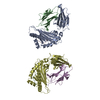
| ||||||||
|---|---|---|---|---|---|---|---|---|---|
| 1 | 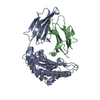
| ||||||||
| 2 | 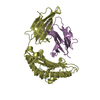
| ||||||||
| Unit cell |
| ||||||||
| Atom site foot note | 1: SIDE CHAIN ATOMS OF A 17, A 194, A 196, B 48, B 58, D 17, D 194, D 196, E 48, AND E 58 ARE DISORDERED, AND HAVE OCCUPANCIES EQUAL TO ZERO IN THIS ENTRY. 2: RESIDUES PRO A 210, PRO B 32, PRO D 210 AND PRO E 32 ARE CIS PROLINES. 3: ESCHERICHIA COLI EXPRESSED BETA-2 MICROGLOBULIN CONTAINS AN N-TERMINAL METHIONINE, IDENTIFIED HERE BY RESIDUE NUMBER 0. |
- Components
Components
| #1: Protein | Mass: 31854.203 Da / Num. of mol.: 2 Source method: isolated from a genetically manipulated source Source: (gene. exp.)   Homo sapiens (human) / Gene: BETA-2-MICROGLOBULIN / Production host: Homo sapiens (human) / Gene: BETA-2-MICROGLOBULIN / Production host:   Escherichia coli (E. coli) / References: UniProt: P01892, UniProt: P04439*PLUS Escherichia coli (E. coli) / References: UniProt: P01892, UniProt: P04439*PLUS#2: Protein |  Beta-2 microglobulin Beta-2 microglobulinMass: 11879.356 Da / Num. of mol.: 2 Source method: isolated from a genetically manipulated source Source: (gene. exp.)   Homo sapiens (human) / Gene: BETA-2-MICROGLOBULIN / Production host: Homo sapiens (human) / Gene: BETA-2-MICROGLOBULIN / Production host:   Escherichia coli (E. coli) / References: UniProt: P61769 Escherichia coli (E. coli) / References: UniProt: P61769#3: Protein/peptide | Mass: 1070.280 Da / Num. of mol.: 2 Source method: isolated from a genetically manipulated source Source: (gene. exp.)   Human T-lymphotropic virus 1 / Genus: Deltaretrovirus Human T-lymphotropic virus 1 / Genus: Deltaretrovirus / Species: Primate T-lymphotropic virus 1 / References: UniProt: P14079 / Species: Primate T-lymphotropic virus 1 / References: UniProt: P14079Compound details | SECONDARY STRUCTURE SPECIFICATIONS WERE MADE BY USE OF THE PROCEDURE OF W. KABSCH AND C. SANDER ...SECONDARY STRUCTURE SPECIFICAT | |
|---|
-Experimental details
-Experiment
| Experiment | Method:  X-RAY DIFFRACTION X-RAY DIFFRACTION |
|---|
- Sample preparation
Sample preparation
| Crystal | Density Matthews: 2.54 Å3/Da / Density % sol: 51.61 % | ||||||||||||||||||||
|---|---|---|---|---|---|---|---|---|---|---|---|---|---|---|---|---|---|---|---|---|---|
Crystal grow | *PLUS pH: 6.5 / Method: vapor diffusion, hanging drop | ||||||||||||||||||||
| Components of the solutions | *PLUS
|
-Data collection
| Reflection | *PLUS Highest resolution: 1.8 Å / Lowest resolution: 30 Å / % possible obs: 88 % / Rmerge(I) obs: 0.042 |
|---|
- Processing
Processing
| Software |
| ||||||||||||||||||||||||||||||||||||||||||||||||||||||||||||
|---|---|---|---|---|---|---|---|---|---|---|---|---|---|---|---|---|---|---|---|---|---|---|---|---|---|---|---|---|---|---|---|---|---|---|---|---|---|---|---|---|---|---|---|---|---|---|---|---|---|---|---|---|---|---|---|---|---|---|---|---|---|
| Refinement | Rfactor Rwork : 0.262 / Rfactor obs: 0.262 / Highest resolution: 2.5 Å : 0.262 / Rfactor obs: 0.262 / Highest resolution: 2.5 Å | ||||||||||||||||||||||||||||||||||||||||||||||||||||||||||||
| Refinement step | Cycle: LAST / Highest resolution: 2.5 Å
| ||||||||||||||||||||||||||||||||||||||||||||||||||||||||||||
| Refine LS restraints |
| ||||||||||||||||||||||||||||||||||||||||||||||||||||||||||||
| Refinement | *PLUS Highest resolution: 2.5 Å / Lowest resolution: 6 Å / Num. reflection obs: 25304 / Rfactor obs: 0.262 | ||||||||||||||||||||||||||||||||||||||||||||||||||||||||||||
| Solvent computation | *PLUS | ||||||||||||||||||||||||||||||||||||||||||||||||||||||||||||
| Displacement parameters | *PLUS Biso mean: 21.3 Å2 | ||||||||||||||||||||||||||||||||||||||||||||||||||||||||||||
| Refine LS restraints | *PLUS Type: x_angle_d / Dev ideal: 2.9 |
 Movie
Movie Controller
Controller


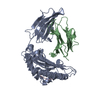
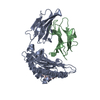
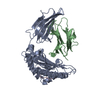
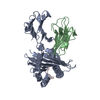

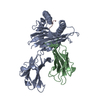


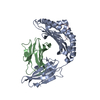


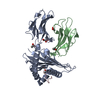

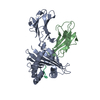
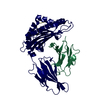

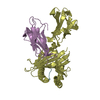



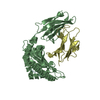
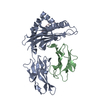
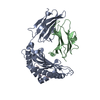
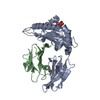
 PDBj
PDBj

